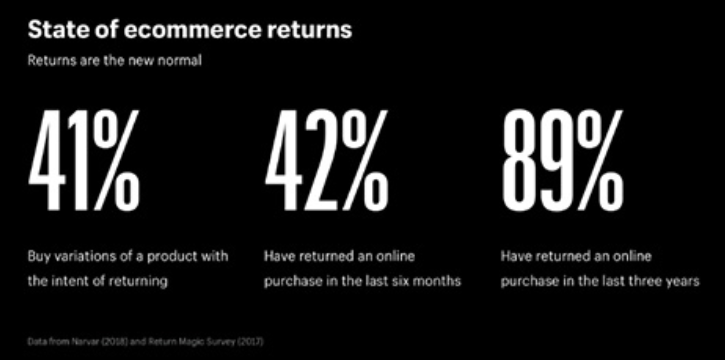
Retailers are offering the most aggressive return policies in history but at what cost. Returns can be a disease, aggressively attacking profit margins, gutting conversion rates, and ultimately threatening your business. In the U.S. alone, Statista estimates return deliveries will cost $550 billion by 2020, 75.2% more than four years prior. Worse, that number doesn’t include restocking expenses nor inventory losses. Nailing down exact numbers on return rates is notoriously difficult, but compiled data from separate sources paints a bleak portrait, especially for online retailers. The fierce competition among online retailers has forced the price margins so low that they cannot support the cost of these return policies.
In response, businesses are adding workers, increasing warehouse space, and establishing separate departments to handle reverse logistics. Returns are the new normal and central to customer experience but they don’t have to be a plague. In fact, how you deal with returns, before and after purchase, can differentiate your brand, create a competitive advantage and even make you more profitable.
Such generous return policies are an invitation for abuse. People are waiting months to return items rendering them useless to the retailer if the item is seasonal. Also, you have people using a particular product and carefully repackaging the item. The ends result is the same; the item is either not available to resell or it is not in sellable condition. Either way your looking at liquidation value for those items.
Some in the industry that created the monster are trying to put it back in its cage. They’re taking baby steps; not providing pre-paid mailing labels, requiring a receipt unless an unwanted item is carried to a store but also threatening to cut off serial returners, the most troublesome of the offenders.
These offenders are indeed a cause for concern among online retailers. Last year, $369 billion in merchandise, or 10% of total retail sales, was returned in the U.S., according to a study by research firm Appriss, up from $260 billion in previous years. The holiday season, of course, is the one to dread in the returns departments. United Parcel Service Inc. expected to handle more than 1 million such packages every day, reaching a peak of 1.9 million on Jan. 2, which would be a 26% increase from the 2019 high point.
How Retailers Are Dealing with Serial Returners
Habitual returners fall into two distinct types:
The Wardrober
People who buy items to wear once and have no intention of keeping them afterward. The Wardrober may not be able to afford the item or are taking advantage of overly lenient policies.
The Fitting Roomer
People who replicate the brick-and-mortar experience at home by purchasing different sizes and colors of the same item, pick their favorite, and return the rest.
In late 2018, The Wall Street Journal reported Amazon had begun banning shoppers — i.e., closing their accounts — who “made too many returns.” While extreme, such actions are often necessitated by the first type of habitual returner. Last year, Amazon also unveiled Prime Wardrobe which is free to members but limited to 3-8 items per order with a seven-day window to return before getting charged.
Retailers are now tracking serial returners and threatening harsh action. The bigger problem is the big retailers have made returns far too easy for shoppers. Trying now to pull back on that ease of shopping experience may backfire. It will be interesting to see the changes for the next holiday season.


 Land-Link, a well respected professional organization, has been providing its clients with effective transportation and logistics solutions since 1978.
Land-Link, a well respected professional organization, has been providing its clients with effective transportation and logistics solutions since 1978.

